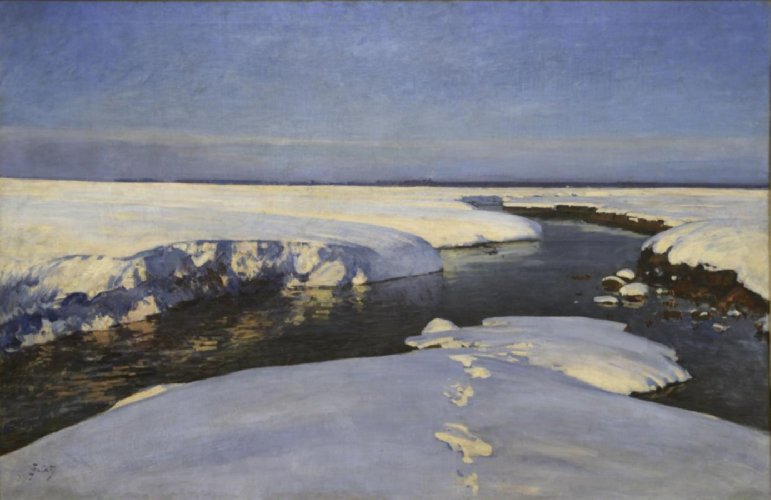Description:
Julian Fałat (1853-1929) came from a peasant family, so he had to combine learning with paid work. Initially, he studied at the Krakow School of Fine Arts, then at the Munich Academy. He became a highly valued watercolorist, as initially he chose this type of painting as much cheaper than oil. In 1888, he received a long-term engagement as a hunter painter at the court of the German Emperor Wilhelm II. In 1895 he became the rector of the Krakow SSP, which under his rule underwent a thorough transformation.
Description of the picture:
He didn’t have an easy start, but everything he achieved was due to his persistence and hard work. He came from a peasant family who couldn’t financially support him during his studies. When his fellow students spent their time in cafés, he was starving, dedicating his free time to work for money. When after graduation many artists went travelling around Europe or continued their studies in Paris, Fałat got a job in an architectural office. He kept drawing and painting with watercolors, since it was much cheaper. After several years he managed to start his studies at the Munich Academy of Fine Arts, where he supported himself by selling his works. He started to be recognized as a watercolorist. His painting was strongly influenced by the academic painting with dark color palette popular in Munich and with watercolors he imitated the effect that was achieved with oil paints.
A life-changing breakthrough was when he was invited by a friend to go on a round-the-world trip. They took the trip on a ship, from which Fałat often painted the coastline of different lands. Japanese art had a big impact on him, as it did on many artists at that time. Under its influence, his palette brightened and he began painting more lightly, leaving some parts unpainted. He also began to search for the balance between truth about nature and its synthesis, generalization, which existed in Japanese art. Many years later, he achieved the understanding that we can observe in his painting “Snow”.
Fałat is mostly associated with hunting scenes, most often with a snow-covered landscape in the background. This was due to the first commission to document the hunting of Antoni Radziwiłł with Emperor Wilhelm II. Since then, he has returned to the topic of hunting multiple times. The emperor hired him as a painter of hunts at the Berlin court, where he spent ten years. He was so associated with this topic that Henryk Sienkiewicz is said to have said at a hunt: It’s amazing! I’m just haunted by Fałat here! I still have to think about him and I see his pictures.
The painting “Snow” is unlike most of Fałat’s works, painted with oil paints. The advantage of this technique is its durability, since watercolor paintings eventually lose their shine and become dull. Interestingly, the painting has not lost its lightness achieved with watercolors. Thus, compared to the first years of his creativity, when the artist imitated the effect of oil paints with watercolors, this time he does the exact opposite. In the painting one can feel a strong connection of the artist with the painted landscape, which arises from his peasant origin and attachment to nature. When in 1895 he became the director of the Academy of Fine Arts in Krakow, he introduced the landscape department with Jan Stanisławski, a landscape painter, at its head. He employed many young professors who changed the direction of the Academy of Fine Arts towards a more modern one, open to Western European trends. One of the important changes was painting landscapes outdoors.
In the painting “Snow” there is a sense of tranquility that comes from the vast, empty landscape without façade, with a certain purity of nature covered with white-blue snow. The water flowing around the foreground island flows through the wasteland in a lazy stream. The harmony of the picture comes not only from the modest composition, but also from the limited colour range. The artist does not flirt, does not paint on the snow another scene of hunting, a lost animal, or even a solitary tree, and on the sky there are no interesting patterns of clouds. He allows himself to create a place that invites more to meditation and contemplation than distraction. Only the traces in the snow coming out of the bottom edge of the painting bear witness to the presence of man in this landscape and shyly invite to take a few steps further, into the depths of the landscape and oneself.


